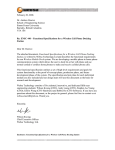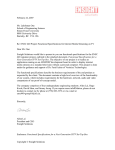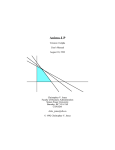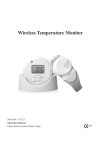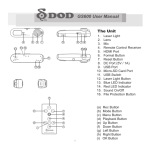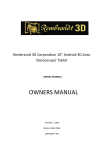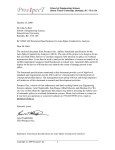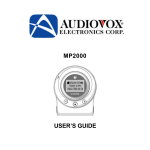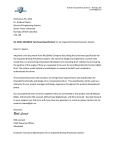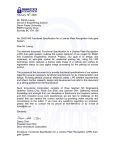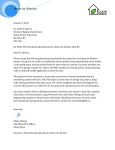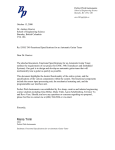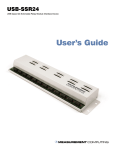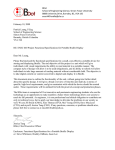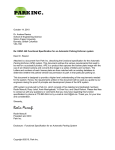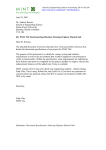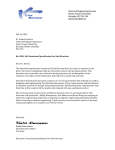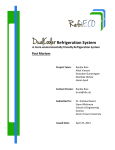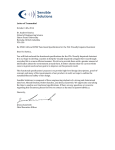Download Mobile medication Alert System Functional
Transcript
School of engineering science Simon Fraser University Burnaby, BC V5A 1S6 [email protected] October 8th, 2012 Dr. Andrew Rawicz School of Engineering Science Simon Fraser University Burnaby, British Columbia V5A 1S6 Re: ENSC 440/305W Functional Specification for a Mobile Medication Alert System (MMAS) Dear Dr. Rawicz: Enclosed is the functional specification for our device, the Mobile Medication Alert System (MMAS), which outlines our Engineering Science 440 Capstone Project. We plan to build, a medical alert system which will physically keep track of a user’s pills and alert them and their designated loved one/caregiver through a smartphone application when they have forgotten or improperly taken their pills. In our functional specification, we will break-down our project into 3 components: microprocessor bundled with WIFI shield and sensors, server and mobile application. Each section will outline the high level requirements of its given components, including integration with other components. This specification will be used by the MMAS team members during the integration and testing phases. SmartMedIncorporated consists of five motivated, innovative, and talented 5th-year engineering students: Li Xiang, Kevin Wang, Steven Verner, Fan Yang and Freda Feng. If you have any questions or concerns about our proposal, please feel free to contact us by phone at 778-882-9418 or by e-mail at [email protected]. Sincerely, Fan Yang Chief Executive Officer SmartMed Incorporated Enclosed: Mobile Medical Alert System Project Proposal Function Specification For the Mobile Medication Alert System Mobile medication Alert System Functional Specification Project Team: Contact Person: Steven Verner Kevin Wang Xue Feng Li Xiang Fan Yang Fan Yang [email protected] Dr.Andrew Rawicz – ENSC440 Steve Whitmore – ENSC305 School of Engineering Science Simon Fraser University Issued date: October 8, 2012 Submitted to: Copyright © 2012, SmartMed Incorporated Page 2 Function Specification For the Mobile Medication Alert System Executive Summary In the modern day over half of American seniors are taking eight or more medications daily and this number is only increasing. Imagine a senior citizen with early onset alzheimers, living on their own and taking more than 10 pills in average per day! The stress alone for them and their loved ones is a major issue, not to mention the fact that forgetting to take a prescription pill can cause even worse results. More pills need to be taken and the medication curing period has to be extended longer than the doctor expected because of drug resistance, and as the number of medications the patient takes increases, it becomes more and more difficult to remember to take them on time. The Mobile Medication Alert System (MMAS) can be a tremendous benefit to assure senior people maintain the correct dosage of their medications and live safe, stress-free lives. Development of the MMAS will take place in three phases: Designing, Building and Testing in four months. After completion of the last phase, the pill dispenser box will have the following core functions: The MMAS will send an alert to the main user’s smartphone when they have failed to remove pills from the dispenser on time, have removed the wrong pills, or if there is a failure in the MMAS system such as loss of power or internet. The MMAS will send a second alert to the caregiver/loved one’s smartphone if the primary user has not responded to an alert after the pre-set deadline is reached. The MMAS will record a chart of the times pills are taken each day and display this data in a chart to allow a doctor or caregiver to keep track of the dosage. The MMAS system will allow seniors around the world and their families to reliably, safely, and easily keep track of their various prescriptions safely while eliminating the stress and danger of missed or improperly taken pills. The MMAS prototype will be completed by December 10th, 2012. In addition, the upcoming phase after the prototype development is massive production phase. We are going to contact local source and meet with investors to put the product on current market. In the meantime we’re also going to develop the app on Android and Windows Phone platform to make it compatible with all decent mobile platforms on market. Copyright © 2012, SmartMed Incorporated Page 3 Function Specification For the Mobile Medication Alert System Table of Contents Cover..........................................................................................................................................2 Table of Contents .......................................................................................................................4 List of Figures ............................................................................................................................6 Glossary .....................................................................................................................................6 1. Introduction ........................................................................................................................7 1.1 Scope............................................................................................................................7 1.2 Intended Audience .......................................................................................................7 1.3 Classification ...............................................................................................................8 2. System Requirements .........................................................................................................8 2.1 System Overview .........................................................................................................8 2.2 General Requirements ...............................................................................................10 2.3 Physical Requirements...............................................................................................10 2.4 Electrical Requirements .............................................................................................10 2.5 Mechanical Requirements .........................................................................................10 2.6 Environmental Requirements ....................................................................................10 2.7 Standards....................................................................................................................10 2.8 Reliability and Durability ..........................................................................................10 2.9 Safety Requirements ..................................................................................................11 2.10 Performance Requirements ......................................................................................11 3. Microprocessor, Sensors and WI-FI Shield......................................................................11 3.1 General Requirements ...............................................................................................11 3.2 Physical Requirements...............................................................................................12 3.3 Electrical Requirements .............................................................................................12 3.4 Mechanical Requirements .........................................................................................12 Copyright © 2012, SmartMed Incorporated Page 4 Function Specification For the Mobile Medication Alert System 3.5 Reliability and Durability ..........................................................................................12 3.6 Safety Standards Requirements .................................................................................13 3.7 Performance ...............................................................................................................13 4. Server................................................................................................................................13 4.1 General Requirements ...............................................................................................14 4.2 Physical Requirements...............................................................................................15 4.3 Reliability and Durability ..........................................................................................15 5. Mobile Application...........................................................................................................15 5.1 General Requirements ...............................................................................................15 5.2 Reliability and Durability ..........................................................................................16 5.3 Performance ...............................................................................................................16 6. User Documentation ............................................................................................................17 7. System Test Plan..................................................................................................................17 7.1 Individual Module Testing ........................................................................................17 7.2Module Integration Testing ........................................................................................18 7.3Final Integrated System Testing .................................................................................19 7.4 User System Testing ..................................................................................................19 8. Conclusion ...........................................................................................................................20 9. References............................................................................................................................21 Copyright © 2012, SmartMed Incorporated Page 5 Function Specification For the Mobile Medication Alert System List of Figures Figure 2.1 System Function Flow Chart Glossary MMAS Mobile Medication Alert System AC Alternation Current DC Direct Current ISO International Organization for Standardization CSA Canadian Standards Association LED Light Emitting Diode Copyright © 2012, SmartMed Incorporated Page 6 Function Specification For the Mobile Medication Alert System 1. Introduction The MMAS (Mobile Medication Alert System) is a system, including both hardware and software components, which helps seniors to take their pills on time every day. The Hardware includes a pill dispensing box with sensors and LED lights built into it. Its function is to check if the pills have been removed from dispensing box on schedule. The server will keep track of which pills are in the box and the schedule for taking them. If the correct pills haven’t been taken on time, the server will send an alert to the user’s associated iPhone App which will in turn alert the user. However, if the user ignores or doesn’t receive the alert within a certain time period, the server will send a second alert to the designated caregiver/loved one’s iPhone app. Finally, the MMAS user’s doctor can access a record of when they have been taking their pills (and missing them) in a convenient chart format on their own iPhone app. 1.1 Scope This document describes all functional requirements for the MMAS prototype including physical, electrical, mechanical and environmental requirements, as well as reliability, durability and safety standards. These requirements fully describe the proof-of-concept device and will also be used to drive future stages of the MMAS product design and development. 1.2 Intended Audience The functional specification document will be used throughout the design, building, and testing phases of the MMAS development. During the design phase, the engineers will be able to refer to the functional requirements as design goals. During the building phase, the engineers will be able to refer to the requirements as implementation goals. During the testing phase, the engineers will be able to test the prototype for the functional requirements described in this document. Copyright © 2012, SmartMed Incorporated Page 7 Function Specification For the Mobile Medication Alert System 1.3 Classification Throughout this document, the following convention will be used to denote functional requirement: [Rn-P] A functional requirement where ‘n’ is the functional requirement number and ‘P’ is the priority of the functional requirement. The priority is shown below: A First Priority: the requirement must be applied to prototype B Secondary Priority: the requirement will apply to prototype if time permits C Tertiary Priority: the requirement will apply to the final production system only not planned for prototype 2. System Requirements General requirements regarding to the Mobile Medication Alert System (MMAS) are present in this section 2.1 System Overview Figure 2.1 outlines the basic functionality of the Mobile Medication Alert System (MMAS). The pill dispenser contains fourteen sections, one for the morning and one for the evening of each day (i.e. Monday Morning, Tuesday Evening, etc). Then sensors communicate their readings to the microprocessor and when a designated time, such as Monday morning, is reached, the microprocessor will turn on an LED under the designated section, until those pills are removed. The microprocessor will also pass the sensor readings to the primary user and loved one/caregiver’s iPhone app through the server and Wi-Fi shield. If the user forgets to take their pills or takes the wrong pills, their iPhone app will display an alert. If the user doesn’t respond within an hour (a time period which can be adjusted from their app), the MMAS will alert their child/caregiver or other designated secondary recipient. An additional alert will appear on both the primary user and loved one/caregiver’s app if there is any failure Copyright © 2012, SmartMed Incorporated Page 8 Function Specification For the Mobile Medication Alert System in the MMAS such as loss of power or internet to the dispenser, in order to insure that they are not relying on the MMAS when it isn’t working properly. Finally a chart of the times about taking pills will be recorded by the app, and the user’s doctor or caregivers will be able to access this chart to check that medication is being taken correctly and on time. Figure 2.1 Schematic of System Functionality Copyright © 2012, SmartMed Incorporated Page 9 Function Specification For the Mobile Medication Alert System 2.2 General Requirements [R1 - A ] The unit must be easy to operate and use. [R2 - B ] The unit must be guaranteed to function from 0-50°C. [R3 - B ] The unit shall have a maximum cost of $600. 2.3 Physical Requirements [R4 - C ] The unit should have variable sizes such as twice/day and quartic/day. [R5 - B ] The dispenser unit should have maximum dimensions 140 cm *80cm* 60cm. 2.4 Electrical Requirements [R6 - A ] The unit must accept as input AC voltage 110~240V 60Hz. [R7 - A ] The unit’s output must less than DC voltage 5V. 2.5 Mechanical Requirements [R8 - A ] It should not be possible for users to dissemble the unit. [R9 - A ] The unit must use insulated material. 2.6 Environmental Requirements [R10 - A ] The unit must be used indoors only. [R11 - A ] The unit must operate normally under operating temperatures range (see R2). 2.7 Standards [R12 - A ] The unit should conform to ISO 9001 standards [1]. [R13 - A ] The unit should conform to CSA standards [2]. 2.8 Reliability and Durability [R14 - C ] The unit should continuously work for at least 1 year without need for Copyright © 2012, SmartMed Incorporated Page 10 Function Specification For the Mobile Medication Alert System maintenance or replacement parts. [R15 - A ] The unit should be resistant to breakage under operating conditions. [R16 - A ] The unit should not require any maintenance. 2.9 Safety Requirements [R17 - A ] The unit must be waterproof against splashed water, but not submersion. [R18 - B ] The unit should have protection from any electronic leakage. [R19 - B ] The unit should have all electronic and mechanical components and power connections enclosed. [R20 - A ] The unit should be able to detect any kind of failure, and notify users. 2.10 Performance Requirements [R21 - A ] The unit should be able to pass on any alert to the user with a maximum of two seconds of data processing time. [R22 - A ] The unit should be able to turn on an LED indicator an hour earlier than the normal taking pill time and turn off the indicator once the pills are taken with maximum of two seconds of total processing time. 3. Microprocessor, Sensors and WI-FI Shield The microprocessor acts as the “brain” of the whole system. It is used to determine whether the correct amount of pills have been taken on time, by processing the signal sent from the weight sensors. It stores the schedule of times when pills should be taken and controls the LED lights under each section of the pill dispenser. The requirements are as follows: 3.1 General Requirements [R23-A] The microprocessor should be able to receive voltage signals sent by the sensors. [R24-A] The microprocessor should be able to respond to the sensor signal intelligently. [R25-A] The microprocessor should be able to send signals to internet via the Wi-Fi shield. [R26-A] The microprocessor should be able to detect a change in readings from the sensors Copyright © 2012, SmartMed Incorporated Page 11 Function Specification For the Mobile Medication Alert System representing the removal of pills from a given section within two seconds. 3.2 Physical Requirements [R27-C] The microprocessor, Wi-Fi Shield, Sensors and pill dispenser box should be encased in a portable unit weighing no more than 1.5kg. [R28-B] The microprocessor should be able to dissipate any heat produced by the MMAS quickly. [R29-C] The microprocessor should not expose any sharp edges or points which could injure the user. 3.3 Electrical Requirements [R30-A] The microprocessor should have sufficient protection from expected static charges. [R31-A] The microprocessor should use the low voltage power supply. 3.4 Mechanical Requirements [R32-C] The base of the microprocessor should have room to fit screws for mounting protective cover. [R33-C] The microprocessor should be shock proofed such that it can withstand being dropped from waist height without damage. [R34-C] The microprocessor should be enclosed in a waterproof protective cover. 3.5 Reliability and Durability [R35-A] The microprocessor should handle simultaneous changes in sensor readings and queries from the server without crashes, error or processing delays of more than three seconds. [R36-A] The microprocessor should be capable for working effectively at temperatures from 0 to 50 degrees Celsius. [R37-A] The microprocessor should trigger an auto-reset function in the case of operation failure. Copyright © 2012, SmartMed Incorporated Page 12 Function Specification For the Mobile Medication Alert System 3.6 Safety Standards Requirements [R38-A] The microprocessor should never overheat to the point where it could burn a user or damage itself. [R39-B] The microprocessor should not generate loud noise, which could disturb the user. [R40-A] Static charges should be dissipated on the microprocessor. 3.7 Performance [R41-A] The microprocessor should be able to handle events in real time. [R42-A] The microprocessor should be able to send data signals to the server in real time. [R43-B] The microprocessor should be able to operate forwithout repair or replacement for a minimum of one year. After some research into the current microprocessor market, we have decided to use the Arduino microprocessor. “Arduino is an open-source electronics prototyping platform based on flexible, easy-to-use hardware and software. It's intended for artists, designers, hobbyists, and anyone interested in creating interactive objects or environments..”[3] In addition to the microprocessor, we have also purchased the WIFI shield kit from the same vendor to bundle with it. We can take advantage of several benefits by using Arduino`s product; it processes quickly and is relatively cheap in price. Furthermore, it has abundant support for development through various online developer communities. 4. Server The server receives a continuous update from the pill sensors, and keeps track of currently available pills, the history of pill consumption, and the schedule of when pills should be taken. From this information the server generates alerts to be sent to the user’s iPhone when they have forgotten or improperly taken a pill, to the caregiver’s iPhone when the user isn’t responding, and to the user’s doctor’s iPhone when he/she requests a history of pill consumption. As the information conduit on which the MMAS relies, the server’s Copyright © 2012, SmartMed Incorporated Page 13 Function Specification For the Mobile Medication Alert System requirements include complete reliability and fail-safes to warn the user of any possible failures in the system. Also since the server communicates with both the microprocessor and the users’ mobile applications, it is required to deal with any erroneous communications without failure. 4.1 General Requirements [R44-A] Accept and store sensor data input from the microprocessor/Wi-Fi Shield and response with proper acknowledgment. [R45-A] Store the schedule for when pills should be taken internally (i.e. Monday Morning Pills should be taken at 9am, Monday Evening at 7pm, etc). [R46-A] Accept a request from the primary user’s iPhone to change the schedule of taking pills (i.e. Monday morning pills should now be taken at 9am not 8am) and save the change. [R47-A] Compare the current sensor readings for which pills remain in the dispenser with the schedule of when the pills should be taken and generate an alert, to be stored internally, when the user has forgotten to take pills or taken the wrong pills. [R48-A] Generate an alert, to be stored internally, if communication with the pill dispenser/microprocessor is lost. [R49-A] Generate an alert, to be stored internally, if a request received from either a mobile app or the microprocessor can’t be read due to improper formatting. [R50-A] Respond to a general query from the primary user’s iPhone App with the Pill sensors’ current data, the current schedule for taking pills, and any internally stored alert (see R47-R49). [R51-A] Generate an alert, to be stored internally, if the primary user hasn’t not responded to an alert (R47-R49) within one hour of its generation, this alert will be passed on to the user’s designated caregiver/loved one’s iPhone App. [R52-A] Respond to a query from the designated caregiver/loved one’s iPhone with any of the stored alerts described in R48, R49 or R51, or with a simple acknowledgement if none of these alerts have been generated. [R53-B] Respond to a query from the user’s doctor’s iPhone app with data on the exact Copyright © 2012, SmartMed Incorporated Page 14 Function Specification For the Mobile Medication Alert System dates and times the user has taken pills in the last 3 months. 4.2 Physical Requirements [R54-A] The server will be hosted by a reputable, reliable web hosting company. 4.3 Reliability and Durability [R55-A] The server will be able to handle any improperly formatted request without Crashing or losing stored data and will generate an alert about such an improperly formatted request (see R49). [R56-A] The server will save its state on a daily basis (minimally) and be able to reboot from its saved state in the case that the server crashes. 5. Mobile Application The MMAS iPhone application allows the user to enter the identification number for a given MMAS pill dispenser and to sign up as either a primary user, a caregiver/loved one, or a doctor. From there, in the case of the primary user or caregiver, the sections of the pill dispenser are displayed as either full or empty, along with the schedule for when the pills in each section should be taken, i.e. Monday Morning 9am, Tuesday Morning 8am, etc. When a given section of the pill dispenser contains pills, and those pills are not removed at the correct time, or if the wrong pills are removed, the user’s app displays an alert and if they don’t respond within a set time period, their designated loved one/caregiver’s app also displays an alert. The user’s doctor can view the history of exactly when pills have been taken in a chart or graph form. Since the MMAS is a medical system and the iPhone application serves as the user interface, it’s primary requirements involve reliability and failsafes insuring the user is warned if anything at all is wrong with the system. 5.1 General Requirements [R57-A] On a new user’s app, allow the user to select primary user, caregiver/loved one, or doctor and enter the identification number of their pill dispenser, in the doctor’s Copyright © 2012, SmartMed Incorporated Page 15 Function Specification For the Mobile Medication Alert System case, multiple identification numbers can be entered. [R58-A] Display an alert, on the primary user’s app, when the they have forgotten totake pills from a specific section on time. [R59-A] Display an alert, on the primary user’s app, when the user has removed pills from the wrong section, a section that doesn’t correspond to the current time. [R60-A] Display an alert, on the caregiver/loved one’s app, when the primary user has failed to respond to an alert within a set period of time. [R61-A] Display an alert, on both the primary user and the caregiver/loved one’s app,when communications are lost with the pill dispenser, such as when it has lost its internet connection or been unplugged. [R62-B] Display an alert, on both the primary user and the caregiver/loved one’s app,when there is a communications failure, such as when a request from the app to the server cannot be decoded. [R63-A] Display, on both the primary user and the caregiver/loved one’s app, which sections of the pill dispenser currently contain pills and the mass of those pills. [R64-A] Display, on the doctor’s app, a chart of the times when the current patient has taken pills over the last 3 months as well as a convenient button and menu for switching between patients. 5.2 Reliability and Durability [R65-B] The iPhone app will be able to handle any improperly received data without crashing or losing stored data and will generate an alert about such data(see R62). [R66-A] The iPhone app will never crash despite any breakdowns in other parts of the MMAS system such as the sensors or microprocessor and it will provide an alert if the system is fully functional. 5.3 Performance [R67-A] The iPhone app should display events and alerts in real time. [R68-A] The app should save the user’s pill dispenser identification number so they only have to enter it once. [R69-A] The app’s user interface should be simple and easy to use and understand even for new users and those unfamiliar with mobile apps. Copyright © 2012, SmartMed Incorporated Page 16 Function Specification For the Mobile Medication Alert System 6. User Documentation [R70-C] User documentation shall include a website with general and technical support information and a user manual, both written in English. [R71-C] The user manual shall be written for an audience with minimal knowledge of electromechanical devices and ergonomics. [R72-C] User documentation shall be provided in French, Spanish, German,Traditional Chinese, Simplified Chinese, and Japanese to satisfy product language requirements for international markets. [R73-C] A detailed installation guide for technicians and vendors shall be created. 7. System Test Plan In order to validate our MMAS system, we decide to implement a rigorous test plan to test each individual module, each integration between modules and the final integrated product. Individual module tests will be conducted on iPhone application, the server, and the microprocessor to verify the basic functionalities. 7.1 Individual Module Testing On the microprocessor, Wi-Fi shield, and sensors, once the development has been completed, test cases based on each of the requirements in section 3 of this document will be created and tested. For example the handling of multiple events in real time will be tested to insure the correct data signal is sent via the Wi-Fi shield to the server and the physical buttons and LEDs will be inspected and individual tested. Similarly, tests for the server and iPhone application, based on the requirements in section 4 and 5 of this document, will be written and thoroughly to insure that each module operates independently without issues. There are many requirements involving the iPhone app acting as a simple and easy-tounderstand user interface. The app requires have notifications which is set by user to remind user to take pills on proper time. Besides, it also requires sending notification to user if he or she forgot to take or mistook the pills and passing the message to caregiver if there is no Copyright © 2012, SmartMed Incorporated Page 17 Function Specification For the Mobile Medication Alert System response received by user. These will be verified directly by software using computer during the coding of app is in progress and after the coding is complete. All hardware parts have functional requirements such as sensitivity and compatibility. The sensors require to detecting the weight of each box and sending the signal back to microcontroller as soon as possible. The microcontroller requires processing the signals send by sensors of each box correctly. These will be tested according to the requirements outlined in this document during and after the microcontroller is programmed. Typical Usage Scenario: Designed to mimic the intended use of the product, the typical usage scenario describes the steps a User would go through to use the Mobile Medication Alert System (MMAS). User downloads the app for smart phone from Store. User set up the app base on his or her own situation, such as what time user should taking pills, who will be the caregiver received the message if there is no response from user. User refill pills once per week to pill boxes for the morning and evening of each day of the week. While it is time for taking pills, user will receive notification from app in smart phone. If user forgot to take or mistake the pills, another notification will send to user, and pass to caregiver if user has no response for the alarm message. 7.2 Module Integration Testing Next, the three major modules, the microprocessor/pill dispenser, the server, and the iPhone application will be individually integrated and tested to insure that the microprocessor and the server are communicating properly, and the iPhone application and the server are communicating properly. The iPhone app and the server will be integrated and will be tested according to the requirements in sections 4 and 5 of this document, to insure, for example, that each alert generated by the server is received and processed correctly by the iPhone. The communication from the iPhone app to the server will also be extensively tested to insure, for Copyright © 2012, SmartMed Incorporated Page 18 Function Specification For the Mobile Medication Alert System example, that requests for information from the app, changes to the medication schedule, etc are received and properly processed on the server side. Similarly the server and microprocessor unit will be individually integrated and tested to insure that communications are flowing quickly and correctly, as outlined by the requirements in sections 3 and 4 of this document. 7.3 Final Integrated System Testing During the third stage of our test plan, the finished prototype including the integrated microprocessor/pill dispenser unit, server, and iPhone app will be tested as a complete system to insure that all functionality described in requirements section of this document is working without bugs or issues. Again a set of unit tests for each of the requirements will be created and tested by the engineers of this group. We expect to implement the following tests on the individual modules and final product. These tests include, but are not limited to: Unit Test C code: execute some unit test code on microprocessor to verify its signal receiving/sending capabilities. LED & Button test: verify the button’s function by manually setting the LED to ON. WIFI connection: inspect the WIFI signal reception of the WIFI shield in various locations in-door by putting it in different places Attenuation test: test the WIFI signal reception when the WIFI shield is covered in the protection package. 7.4 User System Testing The final stage of our test plan will involve non-technical test-users trying out the MMAS system. The user’s will be asked to set up the different types of MMAS user accounts and complete various tasks, such changing the schedule and checking the status of the pills in the pill dispenser according to a uniform list of tasks. Feedback from these users on what is confusing about the MMAS product and what could be done to improve will then be integrated during our final design iteration. Copyright © 2012, SmartMed Incorporated Page 19 Function Specification For the Mobile Medication Alert System 8. Conclusion We have carefully planned every aspect of the development of the MMAS. Therefore, the functional specification clearly expresses the operational functions and industrial standards for successfully developing the MMAS prototype. As a feasibility analysis guide, the team has strong confidence that putting these requirements and standards into developing prototype will lead to the completion of a complete, functional, user-friendly prototype by the target date of December 10th, 2012. Copyright © 2012, SmartMed Incorporated Page 20 Function Specification For the Mobile Medication Alert System 9. References [1 ] International Organization for Standardization, ISO 9001:2008 specifies requirements for a quality management system where an organization,August 25,2008. [Online]. Available:http://www.iso.org/iso/iso_catalogue/catalogue_tc/catalogue_detail.htm?csnumber =46486. [2 ] www.csa.ca/cm/ca/en/standards/products/health-care [3] “Arduino”, Arduino official webpage Oct 02 2012.http://arduino.cc/en/ Copyright © 2012, SmartMed Incorporated Page 21





















